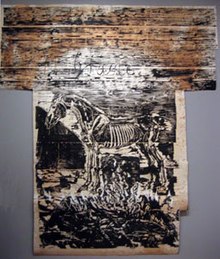張繼高;馬友友;蔣彝、‘The Sorrow of the Nibelungen’, 1974 Anselm Kiefer
In Uncategorized

Previous Post
Next Post
‘The Sorrow of the Nibelungen’, 1974
**
Ma studied at The Juilliard School at age 19 with Leonard Rose and attended Columbia University, but dropped out. He later enrolled at Harvard College. Prior to entering Harvard, Ma played in the Marlboro Festival Orchestra under the direction of cellist and conductor Pablo Casals. He spent four summers at the Marlboro Music Festival after meeting and falling in love with Mount Holyoke College sophomore and festival administrator Jill Hornor during his first summer there in 1972.[16]
Even before that time, Ma gained fame and performed with many of the world's major orchestras. He has also played chamber music, often with pianist Emanuel Ax, with whom he has a close friendship from their days at Juilliard. Ma received his bachelor's degree from Harvard in 1976,[17] and in 1991 received an honorary doctorate from Harvard.[18]
----
For some years now, he has lived with his wife and children in a big, rambling, wooden building, formerly a school, in a remote village in the Odenwald, a region of wooded uplands between Frankfurt and Stuttgart. Not far away is what was once the Nibelungenstrasse, or Road of the Nibelungs. It is a countryside heavy with legend.
Long before the director Patrice Chereau began on the revisionist reading of Wagner's ''Ring'' that is now being shown on public television, Anselm Kiefer took a fresh look at Siegfried and Brunnhilde. That look was epitomized in a very small change that he made in the word ''Nibelungenlied'' (''Song of the Nibelungs'') when he used it as the title of an exhibition in 1973, when he was 28 years old.
That word had stood for nearly 800 years as a symbol of crafty endeavors powered by the craving for vengeance. By turning it into ''Nibelungenleid'' (''Sorrow of the Nibelungs''), Kiefer suggested that those crafty endeavors - vast as had been their musculature - had brought nothing but shame and misery to those who lived by them.
Anselm Kiefer | |
|---|---|
| Born | 8 March 1945 Donaueschingen, Germany |
| Nationality | German, Austrian |
| Known for | Painting, Sculpture, Mixed media |
Notable work | The Hierarchy of Angels (painting) The Secret Life of Plants (sculpture) Grane (woodcut) |
| Spouse(s) | Renate Graf (divorced)[1] |
| Awards | Praemium Imperiale |
Anselm Kiefer (born 8 March 1945) is a German painter and sculptor. He studied with Peter Dreher and Horst Antes at the end of the 1960s. His works incorporate materials such as straw, ash, clay, lead, and shellac. The poems of Paul Celan have played a role in developing Kiefer's themes of German history and the horrors of the Holocaust, as have the spiritual concepts of Kabbalah.

沒有留言:
張貼留言